




Pininfarina S.p.A. (short for Carrozzeria Pininfarina) is an Italian car design firm and coachbuilder, with headquarters in Cambiano, Turin, Italy. It was founded by Battista "Pinin" Farina in 1930. On 14 December 2015, Mahindra Group acquired Pininfarina S.p.A.
Pininfarina is employed by a wide variety of automobile manufacturers to design vehicles. These firms have included long-established customers such as Ferrari, Alfa Romeo, Peugeot, Fiat, GM, Lancia, and Maserati, to emerging companies in the Asian market with Chinese manufactures like AviChina, Chery, Changfeng, Brilliance, JAC and VinFast in Vietnam and Korean manufacturers Daewoo and Hyundai.
It would become arguably the greatest styling studio the world has ever seen. It was the first design studio of its kind to convert, in the mid-Thirties, to monocoque construction. That was a period when Italian car manufacturers were abandoning the traditional ladder frame - a revolution which other coach-builders saw as the death blow to their craft.




1970 ferrari 512 s modulo
The Modulo has an extremely low and wedge-shaped body, with a canopy-style glass roof that slides forward to permit entry to the cabin of the car. All four wheels are partly covered. Another special feature of the design are 24 holes in the engine cover that reveal the Ferrari V12 engine which develops 550 hp to propel the Modulo to a top speed of around 354 km/h and from 0–100 km/h in approximately 3.0 seconds.




2019 pininfarina battista
The Pininfarina Battista is an electric sports car manufactured by Automobili Pininfarina GmbH which is headquartered in Munich, Germany, with roots in the Italian car design firm and coachbuilder Pininfarina. The name Battista is a tribute to Pininfarina's founder Battista Pininfarina. The car was publicly unveiled at the 2019 Geneva Motor Show.
The Battista is powered by a 120 kW⋅h battery pack supplied by Rimac Automobili. The car has four individual motors, each placed at a wheel and they have a combined power output of 1,400 kW and 2,300 N⋅m of torque.




1969 ferrari 512 s concept


Zagato is an independent coachbuilding company and total design centre located northwest of Milan in Terrazzano, a small village near Rho, Lombardy, Italy. The company's premises occupy an area of 23,000 square metres (250,000 sq ft), 11,000 of which are covered.
Ugo Zagato (born in Gavello, near Rovigo, on June 25, 1890) began his coachbuilding career in 1919 when he left Officine Aeronautiche Pomilio to set up his own business in Milan. This was: “the construction and repair of bodies for automobiles and airplanes”.
Ugo Zagato was ferraris exclusive partner in the thirties. In those years even Ansaldo, Bugatti, Diatto, Fiat, Isotta Fraschini, Lancia, Maserati, OM and even Rolls-Royce were clients of Zagato.
Special projects created for Aston Martin, Bentley, Ferrari, Maserati, Spyker, Diatto, and Alfa Romeo consolidate the brand's business in making custom-built models, almost exclusively coupés with two doors and two seats.

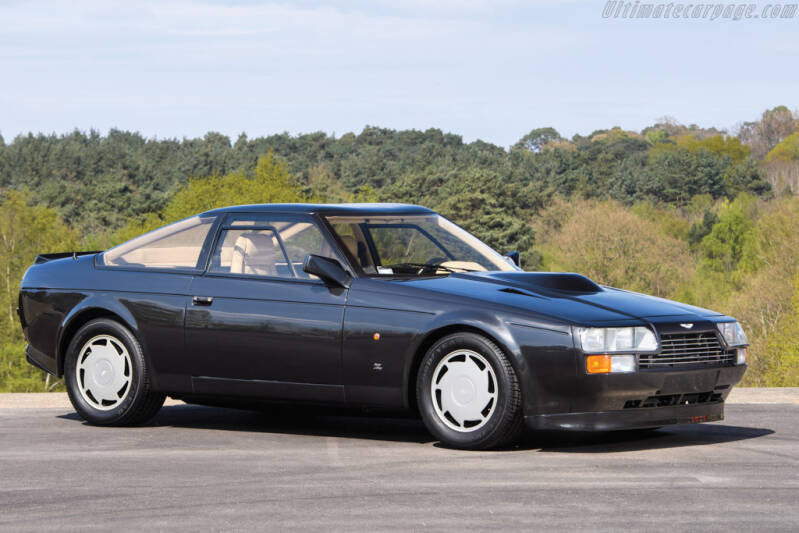
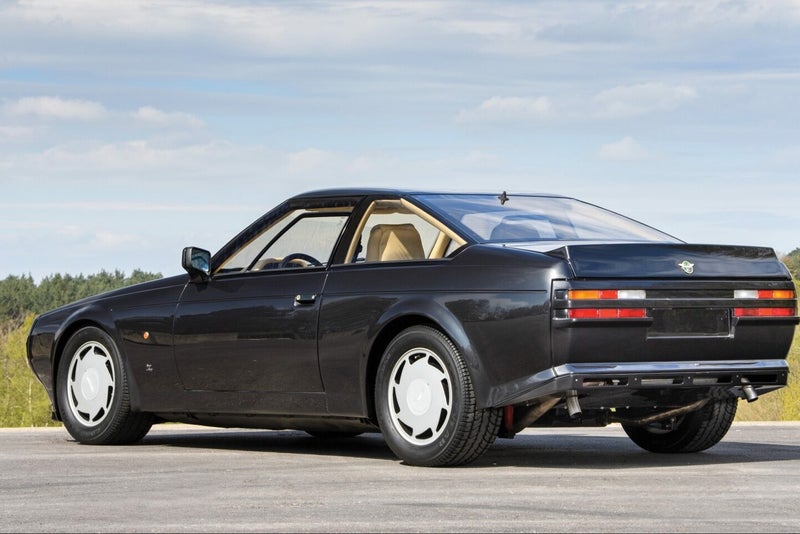

1986 aston martin v8 vantage zagato coupé
The new Vantage Zagato was first shown as a design at Geneva in 1985. All 50 copies were bought on the basis of drawings and a scale model. A Volante version made its debut at the 1987 Geneva Auto Show and was offered at an even more limited run of only 25, although a total of 37 were eventually made due to high demand.




2020 aston martin dbs gt zagato special
An extensively reworked version of the DBS Superleggera supercar, the DBS GT Zagato sees power from the 5.2-litre turbocharged V12 boosted from 715bhp to 760bhp. The exterior features an exclusive Supernova Red paint colour, exposed carbon-fibre accents, black and gold 3D-machined wheels and 18-carat gold badging.
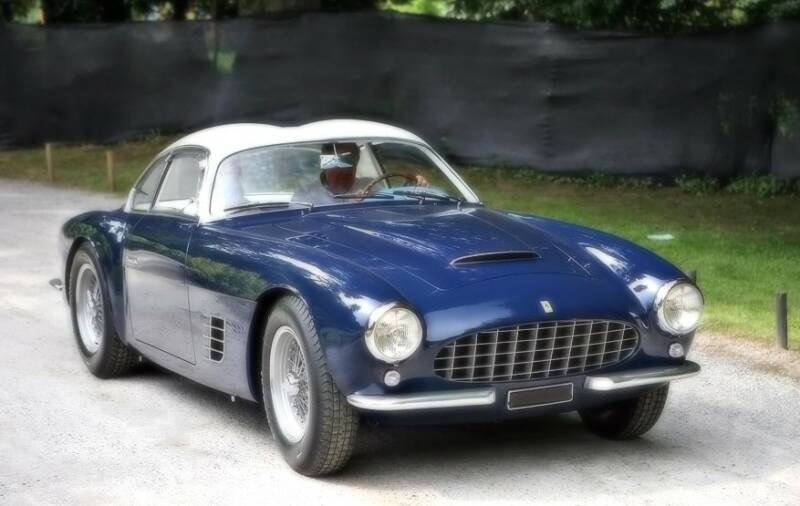



1956 ferrari 250 gt zagato
Ferrari and Zagato’s relationship formed one of the most desirable ‘marriages’ in car design, the 250GT Zagato (GTZ). It was their most successful collaboration and only a few were ever made for requesting clients. As the ultimate combination, the GTZ allied the already proven Ferrari 250 Tour de France chassis with Zagato’s curvaceous low drag body. Throughout Ferrari’s colorful and successful history, only ten customer-bought Ferraris were bodied by Zagato up to 1973, making these cars one of the hardest to see in person.


Gruppo Bertone, commonly known simply as Bertone, was an Italian automobile company, which specialized in car styling, coachbuilding and manufacturing. Bertone styling is distinctive, with most cars having a strong "family resemblance" even if they are badged by different manufacturers. Bertone has styled cars for Abarth, Alfa Romeo, Aston Martin, Citroën, Ferrari, FIAT, Iso, Lancia, Lamborghini, Mercedes-Benz, Opel and Volvo, among others. In addition, the Bertone studio was responsible for two of the later designs of the Lambretta motorscooter. In the late 1980s, Bertone styled the K20 motorcycle helmet for Swiss bicycle and motorcycle helmet manufacturer Kiwi.
Designer Nuccio Bertone took charge of the company after World War II and the company was divided into two units: Carrozzeria for manufacturing and Stile Bertone for styling. Until its bankruptcy in 2014, the company was headed by the widow of Nuccio Bertone, Lilli Bertone.




1967 alfa romeo montreal
Bertone’s Marcello Gandini (born 1938), the man who designed the Alfa Romeo Montreal – so-called as it was launched as a concept at Expo ’67 in the Canadian city – was born into art. The son of a Turinese orchestral conductor, he’s now considered a prince among automotive designers.
From the slatted headlamp covers to the louvred B-pillars to the Kamm tail, the Montreal is one of Bertone’s most recognisable – and best-loved – designs.




1974 lamborghini countach
Lamborghini’s beginnings may have been prosaic – its founder, Ferruccio Lamborghini (1916-1993) began his business reconditioning tractors left behind by Allied forces after World War Two – but in 1971 they unleashed a concept for a vehicle that would come to define the term ‘sports car’ to many.
The scissor doors may be the showboat of Gandini’s design, but his ‘cab forward’ concept to accomodate a rear mid-engine would have a pervasive influence on high-end car design in ensuing years.

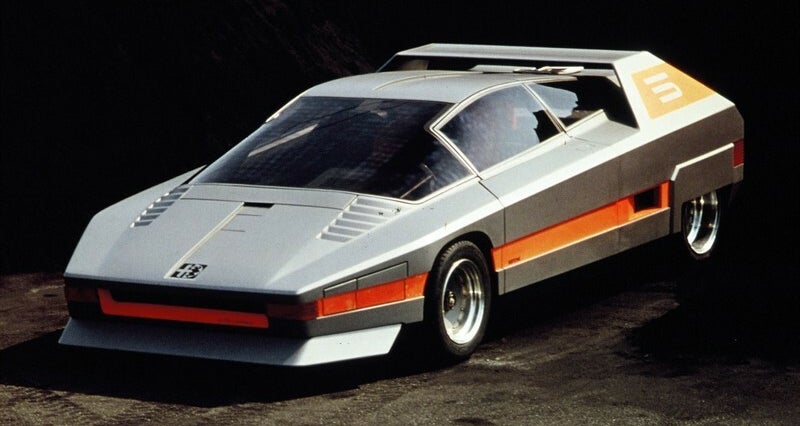


1976 alfa romeo navajo
The beautiful Alfa Romeo 33 Stradale served as the basis for several concept cars by Italian coachbuilders, including the Alfa Romeo Carabo. But the last was certainly one of the oddest. Designed by Nuccio Bertone himself, the Alfa Romeo Navajo debuted at the 1976 Geneva motor show and featured hefty active spoilers and a unique pair of pop-up headlamps that were set in the front wings rather than bonnet.


Carrozzeria Vignale was an Italian automobile coachbuilder company. Carrozzeria Alfredo Vignale was established in 1948 at Via Cigliano, Turin[1] by Alfredo Vignale (1913–69) in Grugliasco, near Turin (Torino).
The first body on a Fiat 500 Topolino base was made in 1948, followed by a special Fiat 1100. Most customers were Italian firms such as Cisitalia, Alfa Romeo, Ferrari, Fiat, Maserati, Lancia. In 1952, Vignale collaborated with Briggs Cunningham to jointly produce the Continental C-3. A close cooperation was maintained with Giovanni Michelotti, who in 1959 opened his own design studio and in 1962 definitely concluded the cooperation.
Vignale was taken over by De Tomaso in 1969 who already owned Carrozzeria Ghia. Shortly after selling, Alfredo Vignale died in a car crash on November 16, 1969. Both coachbuilder firms were sold to Ford in 1973 but the Vignale brand was discontinued.

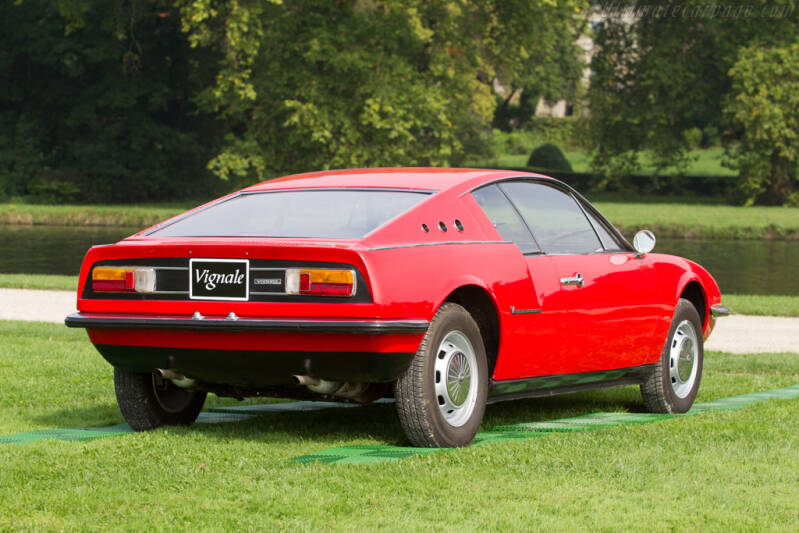


1968 matra m530 sport vignale
In 1968 Vignale presented a prototype, designed by Virginio Vairo, and based on the platform of a Matra M530. The car made its first appearance in Geneva painted yellow. Later the car was shown at the Vignale stand in Turin with some minor body modifications and painted red and white. It is not exactly known whether this car was a two-times repainted one-off or that Vignale had built more than one.



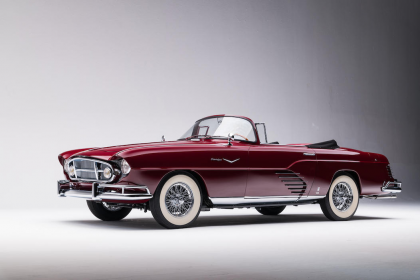
1953 fina sport
The Fina-Sport was an American automobile manufactured from 1953 until 1954. The brainchild of Perry Fina, it used a 210 hp Cadillac V-8 engine and Hydramatic transmission mounted on a Ford chassis. Styling of both convertibles and hardtops was by Vignale.
The first Fina Sport was built as a coupe, its power came from a Cadillac motor reworked by the Finas to give 300bhp.
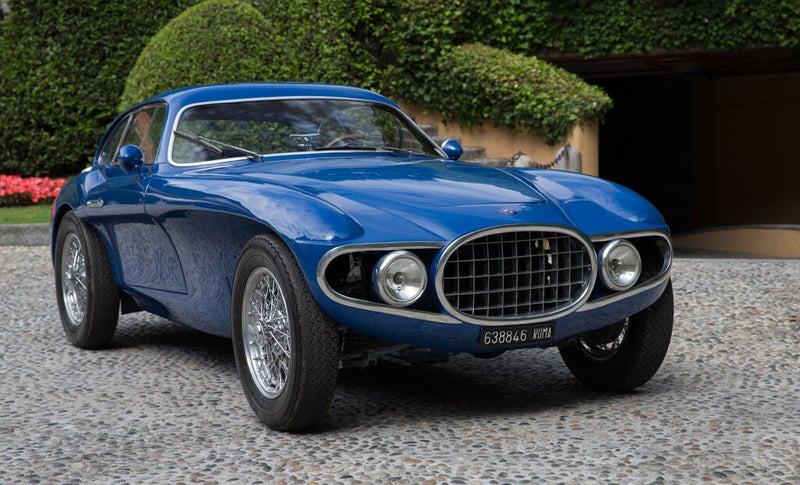



1952 osca mt4
Carrozzeria Vignale was responsible for this intriguing Michelotti-styled machine with its cutaway flanks, zig-zag waistline, crisply-outined nose and minimal front overhang. It was commissioned as a one-off by Turin chemist Mario Damonte to contest the 1952 24 Hours of Le Mans, in which Damonte, partnered by Fernand Lacour, retired after 19 hours with clutch trouble. The ‘MT4’ stands for ‘Maserati Tipo 4 Cilindri’. Based on Fiat’s 1092cc block and topped with OSCA’s own aluminium cylinder head, power was raised to an impressive 100bhp.


Italdesign Giugiaro S.p.A. is a design and engineering company and brand based in Moncalieri, Italy, that traces its roots to the 1968 foundation of Studi Italiani Realizzazione Prototipi S.p.A. by Giorgetto Giugiaro and Aldo Mantovani. Best known for its automobile design work, Italdesign also offers product design, project management, styling, packaging, engineering, modeling, prototyping and testing services to manufacturers worldwide. As of 2010, Italdesign employs 800 people.
On August 9, 2010, Volkswagen Group subsidiary Audi's subsidiary Lamborghini acquired 90.1% of the shares of Italdesign Giugiaro S.p.A., including the brand name rights and patents. The remaining shares were sold to Audi on 28 June 2015, with Giorgetto Giugiaro resigning from the firm at the same time.
Volkswagen and Italdesign have a history of working together that dates back to the early 1970s and includes the Golf mkI.




1971 alfa romeo caimano
The Alfa Romeo Caimano is a concept car designed by Giorgetto Giugiaro of Italdesign and presented at the Turin Motor Show in 1971. The car is exhibited at the Museo Storico Alfa Romeo. The Caimano features many unconventional design elements, one of the most striking being its large glass canopy-windshield, which incorporates the doors as well. The B and C pillars form a trapezoidal roll bar in the rear of the car, which also doubles as an adjustable spoiler which can be controlled from inside the cabin.




2017 Italdesign zerouno
The Italdesign Zerouno is a sports car produced by Italian Automotive styling house Italdesign Giugiaro and was introduced in 2017. The Zerouno is the first car sold under the name of the Moncalieri design house and was created by their Italdesign Automobili Speciali division. The name means "Zero One", as it is the first production vehicle from Italdesign's low production sports car division, Italdesign Automobili Speciali.




1971 maserati bora
The Bora was designed by Giorgetto Giugiaro at Italdesign and has a drag coefficient of 0.30. Compared to other supercars, it was civilized and practical, featuring a hydraulically powered pedal cluster that could be moved forward and backwards at the touch of a button and a steering wheel that could be tilted and telescoped, addressing the familiar problem of entering and exiting the vehicle typical of many supercars.


Carrozzeria Ghia SpA (established 1916 in Turin) is an Italian automobile design and coachbuilding firm, established by Giacinto Ghia and Gariglio as Carrozzeria Ghia & Gariglio. The headquarters is located at Corso Guglielmo Marconi, 4, Turin, Italy.
Ghia initially made lightweight aluminium-bodied cars, achieving fame with the Alfa Romeo 6C 1500, winning Mille Miglia (1929). Between the world wars, Ghia designed special bodies for Alfa Romeo, Fiat, and Lancia, one of the most famous was the Fiat 508 Balilla sports coupe (1933). The factory was rebuilt at Via Tomassi Grossi, after being demolished in an air raid during World War II (1943). After Ghia's death (1944), the company was sold.
Ghia studios are now an integral part of Ford of Europe's styling operation - producing mostly concept cars.




1970 detomaso pantera
The Pantera was designed by the Italian design firm Carrozzeria Ghia's American-born designer Tom Tjaarda and replaced the Mangusta. The car debuted in Modena in March 1970. Approximately a year later the first production cars were sold, and production was increased to three per day. De Tomaso sold the rights to the Pantera to Ford, who were to distribute the cars in the United States, but Alejandro De Tomaso retained the rights to market the Pantera in Europe.

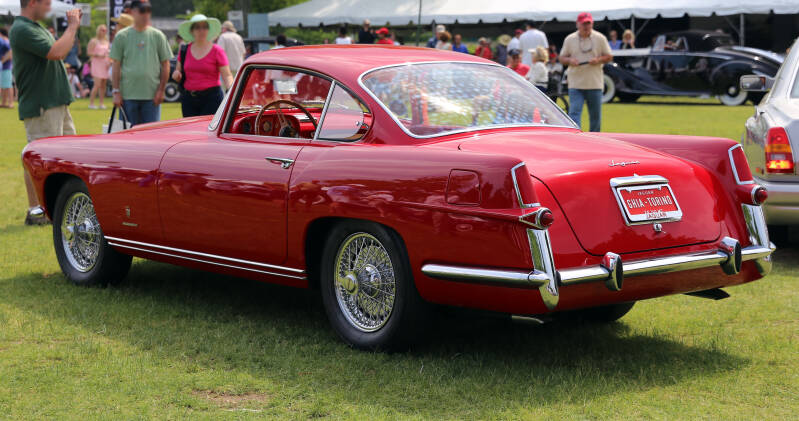


1965 jaguar xk140 mc
The Jaguar XK140 (Ghia) was a custom bodied Jaguar XK140 with all-aluminum fastback coachwork by Ghia of Italy with only three made in 1965. The cars were also known as the Jaguar XK140MC. The car looks more Mediterranean both inside and out, similar to that of Maserati or a Pegaso. There’s even a hint of Ferrari in those fenders. The cars were fitted with dual overhead-camshaft engines which run a C-Type head boosting its output by 20 horsepower to 210 total.




1953 fiat 8v supersonic
At the 1952 Geneva Motorshow, Fiat stunned the gathered crowd with an all new car, developed especially for racing. Powered by a 2 litre V8 engine, the car was simply known as '8V' or 'Otto Vu' in Italian. This to prevent problems with Ford, who, Fiat believed at the time, had claimed the V8 type-name. It was designed specifically to take on the two litre class, which was a highly contested class of the Italian championship.


Carrozzeria Touring Superleggera is an Italian automobile coachbuilder. Originally established in Milan in 1925, Carrozzeria Touring became well known for both the beauty of its designs and patented superleggera construction methods. The business folded in 1966. In 2006 its brands and trademarks were purchased and a new firm established nearby to provide automotive design, engineering, coachbuilding, homologation services, non-automotive industrial design, and restoration of historic vehicles.
Carrozzeria Touring was established on 25 March 1926 by Felice Bianchi Anderloni (1882–1948) and Gaetano Ponzoni. After achieving success through the middle of the 20th century, the business began to decline as automobile manufacturers replaced body-on-frame automobile construction with unitary design and increasingly took coachbuilding in-house.
After the original firm ceased production in 1966, Carlo Felice Bianchi Anderloni and Carrozzeria Marazzi preserved the "Touring Superleggera" trademark and used it on several occasions to support the company's heritage. The trademark was acquired by the current owner, a family business, which began conducting its activities in 2006 under the name Carrozzeria Touring Superleggera S.r.l.; the new firm is headquartered nearby Milan, its hometown.



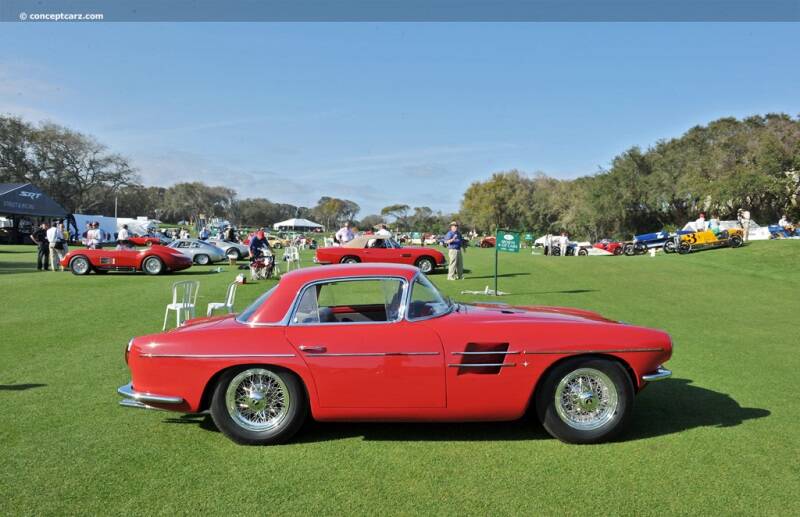
1955 pegaso z103
The Pegaso Z-103 was a Spanish sports car produced by Pegaso from 1955 to 1958. The Z-103 was the second, and last, sports car made by Pegaso before the company switched their focus back to commercial trucks. The car had little success and only 3 were known to have been built. A Z-104 sedan had also been in the works but the idea never reached fruition. Additionally, another Z-103 was assembled in 1962 from spare parts leftover from the production of the original cars.




1952 alfa romeo disco volante
The Alfa Romeo 1900 C52 "Disco Volante", commonly known simply as Alfa Romeo Disco Volante (Italian for "Flying Saucer"), is a series of experimental sports racing cars produced between 1952 and 1953 by Italian car manufacturer Alfa Romeo in collaboration with Milanese coachbuilder Carrozzeria Touring. The car was distinguished by streamlined, wind tunnel tested bodywork.




1964 lamborghini 350gt
The Lamborghini 350 GT was a grand tourer manufactured by Lamborghini between 1964 and 1966. It was the first production vehicle produced by Lamborghini. The 350 GT was based on the earlier Lamborghini 350 GTV and was equipped with a 3.5 liter V12 engine and a 2-door coupé body by Carrozzeria Touring. The success of this model ensured the company's survival, establishing it as a viable competitor with rival manufacturer Ferrari.


Carrozzeria Scaglietti was an Italian automobile design and coachbuilding company active in the 1950s. It was founded by Sergio Scaglietti in 1951 as an automobile repair concern, but was located across the road from Ferrari in Maranello outside Modena, Italy.
Scaglietti gained Enzo Ferrari's trust and respect both through his bodywork and design skills and for providing a retreat for young Dino Ferrari. Their professional relationship began when Ferrari asked Scaglietti to repair and modify race car bodywork in the late 1940s, which was soon followed by orders for full car bodies in the early 1950s.
Today, the former Scaglietti works is owned by Ferrari and used to produce Ferrari's current line of aluminium bodied cars, including the 488 and F12, using both modern and traditional techniques. In 2002, a special edition of the 456, the 456M GT Scaglietti was named in honor of Scaglietti. This was followed by the 2004 introduction of the 612 Scaglietti, a 2+2 GT car produced until 2010. Despite names honoring Scaglietti, both the 456 and 612 were designed by Pininfarina.




1958 ferrari 250 testa rosso
The name “250 Testa Rossa” refers to the car’s unit displacement (250 cc x 12 = 3000 cc) and also to the particular color of the valve covers, which was a means of identifying, during production, the specific type of competition engine. The “barchetta” body was created by Sergio Scaglietti in beaten aluminum.




1952 ferrari 250 gt california
Luigi Chinetti, importer of Ferrari cars in North America, asked Enzo Ferrari for a sportier model to offer alongside the 250 Cabriolet Pininfarina. Taking the latter as his starting point, Scaglietti created the wonderful California. It was built using steel panels, with aluminum doors and hood, and in both short and long wheelbase versions. In addition, nine specimens were built entirely in aluminum.




1959 Scaglietti corvette
Through Chevrolet general manager Ed Cole, three chassis were taken off the assembly line and sold without bodies. These were shipped to Italy where a divine transformation turned the Corvette outwardly into something more like a Ferrari. At the time Scaglietti & C. was building the bodies for Ferrari’s ‘Tour de France’ Berlinetta, so the resemblance wasn’t accidental. Laughlin requested the car retain its Corvette grille. Inside the interior had Stewart Warner gauges and Corvette knobs.


Giovanni Michelotti (6 October 1921 – 23 January 1980) was one of the most prolific designers of sports cars in the 20th century. His notable contributions were for Ferrari, Lancia, Maserati and Triumph marques. He was also associated with truck designs for Leyland Motors, and with designs for British Leyland (including the Leyland National bus) after the merger of Leyland and BMC.
Born in Turin, Italy, Michelotti worked for coachbuilders, including Stabilimenti Farina, Vignale, Allemano, Bertone, Ghia, Ghia-Aigle, Scioneri, Monterosa, Viotti, Fissore and OSI, before opening his own design studio in 1959. He also cooperated with manufacurers producing their own cars based on Fiat or other mechanicals, like Siata, Moretti, Francis Lombardi and Nardi. From 1962, Michelotti concluded cooperation with Carrozzeria Vignale and began his own coachbuilding activities.
Towards the end of his life, asked whether he had ever designed anything other than cars, Michelotti acknowledged that virtually all of his design work had involved cars, but he admitted to having designed a coffee making machine shortly after the war.

1962 triumpf spitfire



The Triumph Spitfire is a British front-engined, rear-wheel drive, two-passenger convertible sports car manufactured between 1962-1980. Styled for Standard-Triumph in 1957 by Italian designer Giovanni Michelotti. The Spitfire nameplate refers to the World War II fighter plane of the same name.
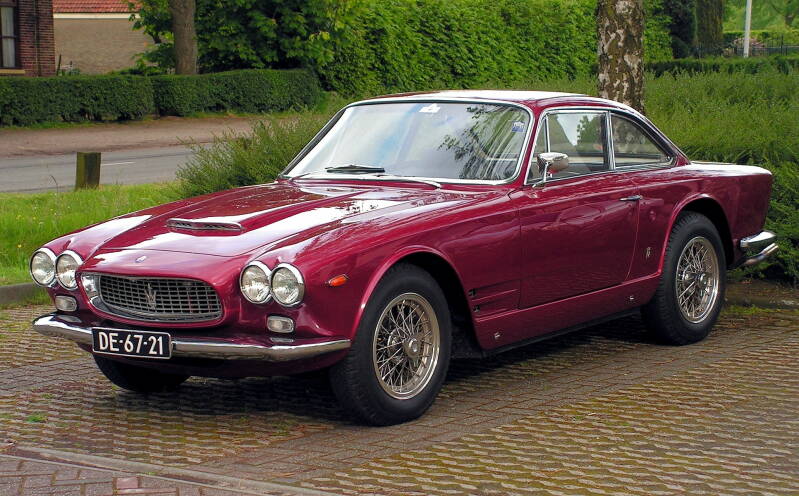
1962 maserati sebring



The Maserati Sebring was a two-door 2+2 coupé manufactured by Maserati from 1962 until 1968. Based on the Maserati 3500, the Sebring was aimed at the American Gran Turismo market and named after Maserati's 1957 racing victory at the 12 Hours of Sebring. A single two-seat spyder was built by Vignale in 1963 but did not enter production.

1961 alpine a110



The Alpine A110 is a sports car produced by French automobile manufacturer Alpine from 1961 to 1977. The car was styled as a "berlinette", which in the post-WWII era refers to a small enclosed two-door berline, better-known as a coupé. The Alpine A110 succeeded the earlier A108. The car was powered by a succession of Renault engines. A continuation of the A110, developed under Renault-Nissan partnership, was introduced in 2017.


Designworks is a global creative consultancy owned by BMW and based in Newbury Park, California, United States. Designworks has two further studios, in Munich, Germany and Shanghai, China. Established independently in 1972 by Charles Pelly, it became a wholly owned BMW Group subsidiary in 1995, and was instrumental in the design of the BMW XL Sports Activity Vehicle and the BMW 5 Series. Other development projects at Designworks have included the BMW electric car, BMW 8 Series (E31) seat, BMW 3 Series (E46), BMW Z8, BMW 7 Series interior, and BMW 100- and 1200 Touring motorcycles, among many others.
In 1991, BMW acquired a large percentage of the company, and Designworks started its first car exterior design project in 1993 for the 1998 BMW 3 Series (E46).




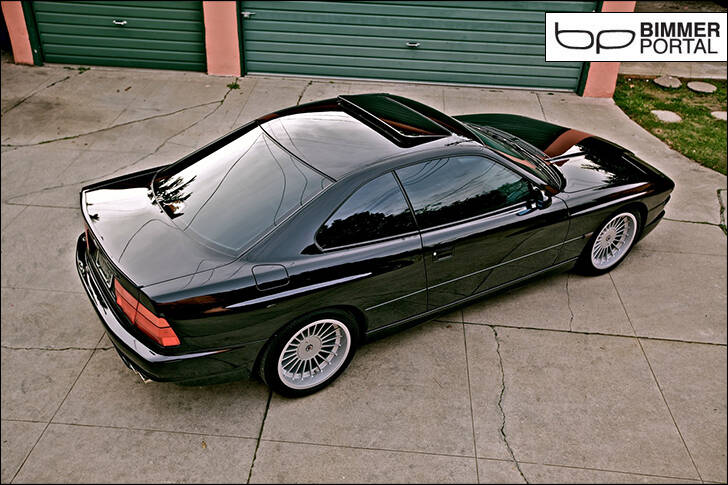
1990 bmw 8-series
The BMW E31 is the first generation of the BMW 8 Series. It is a grand tourer built by BMW from 1990 to 1999 powered by either a V8 or V12 engine. While it did supplant the original E24 based 6 Series in 1990, a common misconception is that the 8 Series was developed as a successor. It was actually in an entirely new model class aimed at a different market, with a substantially higher price and performance than the 6 Series.
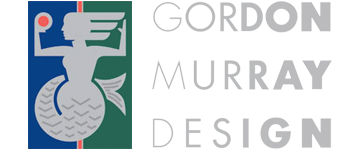

Ian Gordon Murray CBE (born 18 June 1946 in Durban, Union of South Africa),is a South African-born British designer of Formula One racing cars and the McLaren F1 road car. Murray moved to England in 1969, hoping to find a job at Lotus Cars. But Murray was offered a job at Brabham after coincidentally meeting then Brabham designer Ron Tauranac. After leaving Brabham, Murray had received an offer from Ron Dennis and joined McLaren as Technical Director on a three-year contract taking over the role formerly held by John Barnard. In July 2007 the Gordon Murray Design consultancy was established, and released initial details regarding its upcoming T.25 (Type 25) prototype city car.

1992 mclaren f1



The McLaren F1 is a sports car designed and manufactured by British automobile manufacturer McLaren Cars, and powered by the BMW S70/2 V12 engine. The original concept was conceived by Gordon Murray. Murray was able to convince Ron Dennis to back the project.

1991 light car company rocket



The Rocket is an ultra-lightweight, open cockpit roadster powered by a 1-litre motorcycle engine, which has an appearance similar to that of a 60's era Grand Prix car. Looking like a single-seater, it could accommodate a passenger in tandem with the driver, the second seat located beneath a removable cover. The Rocket was built by former racing driver Chris Craft at the Light Car Company.

1986 brabham bt55



The Brabham BT55 was a Formula One racing car designed by Gordon Murray and David North for the Brabham team owned by Bernie Ecclestone. It used a BMW four-cylinder turbocharged engine tilted over on its side to allow a clear supply of air to the rear wing. The car competed during the 1986 Formula One season.


First started in Turin (the capital of Italian design) by eleven industrial and automotive designers, therefore “One One Lab”. Subsequently the studio shifted its headquarters to the center of Europe. Particularly to have a more strategical location to fulfill the demand of the international market.
Along with this One One Lab will soon open two satellite studios in Shanghai – China and Mexico City.

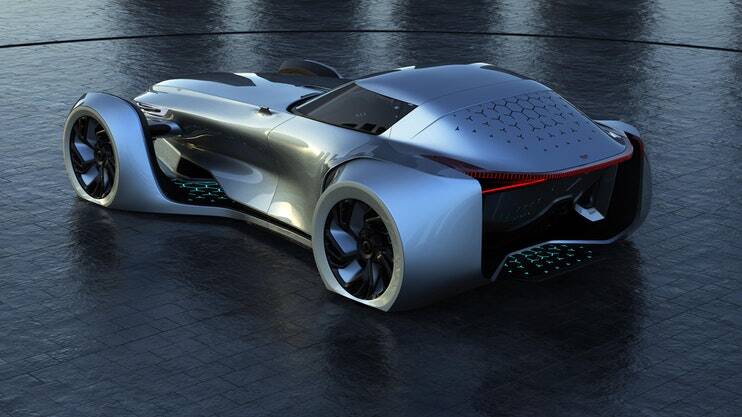


The Donkervoort EVx by One One Lab
The EVx is a fully electric future vision of Donkervoort. The very characteristic layout gave them many possibilities but always keeping in mind that it still has to be an extraordinary track car they did not want to push the border too far. Realism was very important but so it was the study of surfaces and details. A removable hard top changes the user experience by giving a more traditional open air Donkervoort. Not having an internal combustion engine made possible to have a seating position more similar to an F1 car and creating an empty space under the hood as if the front part was hoovering

zacua



Zacua is a quite new “EV” electric car company based in Mexico.
Zacua’s vision to develop a compact electric city car for the world’s largest cities such as Mexico City is quite interesting, however the road for a new, small company can be treacherous specially in the automotive design area. Zacua`s first two models while completely engineered by them, had to borrow the design from Chatenet Automobiles.

syrma hypersport



The Syrma Hypersport is where it all began for One One Lab Design Studio.
Eleven Concepts were developed by eleven car designers. One of the most beautiful automotive design projects from the founders of the Design Studio.
Designed, developed and built in Turin Italy. The 1:1 Prototype was unveiled at the Geneva Motor Show 2015. To give the driver an optimal view of the surroundings, the three-seater cab has the driver's seat centrally in front . A hybrid unit with a double-supercharged V6 engine and an electric motor was chosen as the source of propulsion, offering a total power of approximately 900 HP , while meeting strict ecological requirements and thus allowing movement in city zones closed to ordinary cars.


The Swedish design firm Paulin Motor Company, led by former Ford designer Daniel Paulin, is a company which attempts to predict the future design direction of vehicles. The Paulin concept is "about simplicity and functionality in true Scandinavian fashion." Paulin has designed products with the following partners: Devon Motorworks, McLaren Group, Volvo Cars, Volvo Trucks, Tata Motors, SSangYong, Hyundai Motor Company, Kia Motors, Scania, Iveco, Caran, MG Rover and Motorcity Europe.
Paulin Motor Company is based in Gothenburg, Sweden and is a global design agency for advanced automotive design, offering services that range from early conceptual work to finished concept cars. It was founded in 2005.

vr concept



The VR Concept is a 2-seat sportscar designed for the year 2010. It is the first creation of Swedish Paulin Motor Company.
The exterior is characterized by the cockpit design, which is inspired by modern jet-fighters, and by the original scheme of the opening panels. The windshield/roof is hinged in the cowl area. With windshield/roof in open position, the doors can be open independently. The rear wing is integrated in body with a flush condition. In use it moves up and rotates to create appropriate down force.
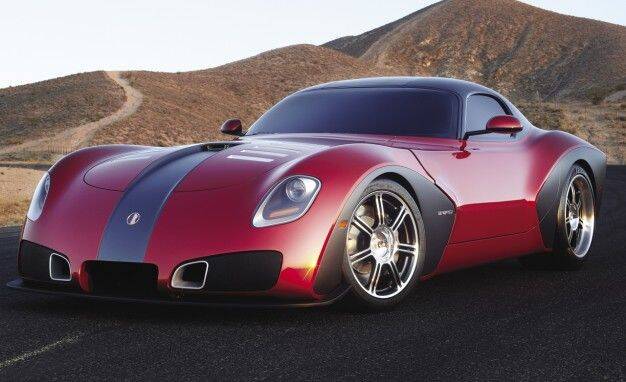
devon gtx
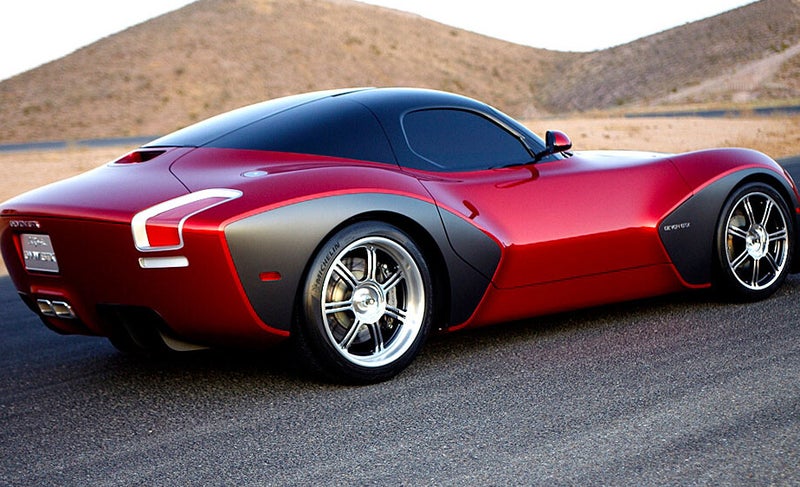


The 2010 Devon GTX, officially introduced at the Pebble Beach Concours d’Elegance, hopes to make a name for itself as a track star in addition to a lusted-after road-going exotic. While the attempt at buying the Viper brand earlier this year failed, Los Angeles-based Devon Motorworks nonetheless decided to design and build their own American supercar, using the Viper’s chassis and powertrain as a starting point.
The GTX packs an 8.4-liter Viper V-10 engine, which cranks out 650 hp (50 more than the Dodge’s).

2004 fab1



FAB 1 is a pink, six-wheeled car seen in the 1960s British science-fiction television series Thunderbirds, its three film adaptations and its reboot, Thunderbirds Are Go. In the 2004 live-action film, Thunderbirds, FAB 1 is still pink and powered by a six-wheel drive. Its glass canopy is tinted, and it is now capable of flight as well as travel on land and sea. Prior to flight, the car's boot panels open, exposing the gas turbine engine; the wings then extend from the undercarriage. During flight, the rear set of wheels folds into the main vehicle body to prevent unnecessary drag. The passenger compartment doubles as a life raft in the event of an emergency at sea, while buoyancy tanks hidden in the body panelling ensure that the compartment remains afloat after it has broken away from the rest of the vehicle.


Phil Frank, Principal of *PFD runs this small fast paced design consultancy with a unique personal approach focused on delivering innovative solutions that address each client's consumer, market, process and DNA. From custom car design to consumer electronics, lifestyle accessories to retail environments, Fortune 500 to entrepreneurial start-ups *PFD delivers innovative, consumer focused objects of desire.

nike one

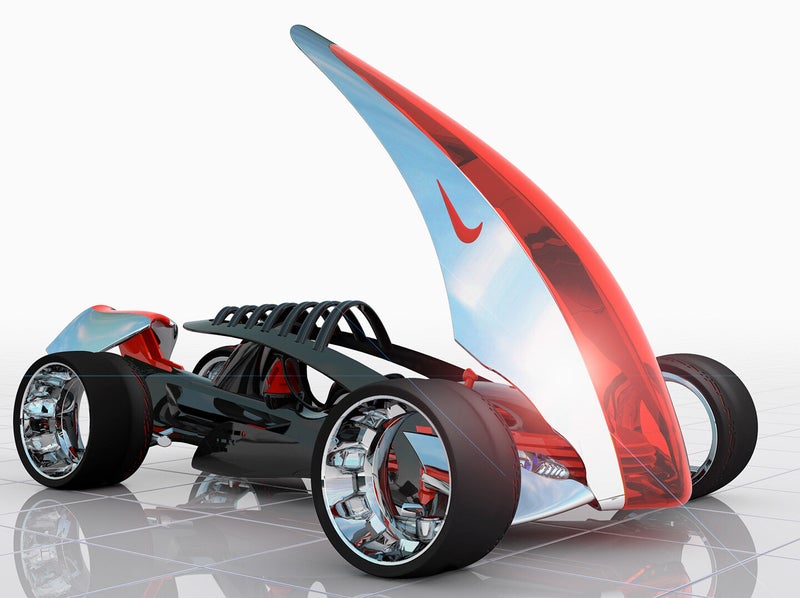

The Nike One 2022 is the epitome of blue sky creative brand expression. A vehicle designed from the inside out around a human as the control and power center. Conceptualized as training equipment for the track.
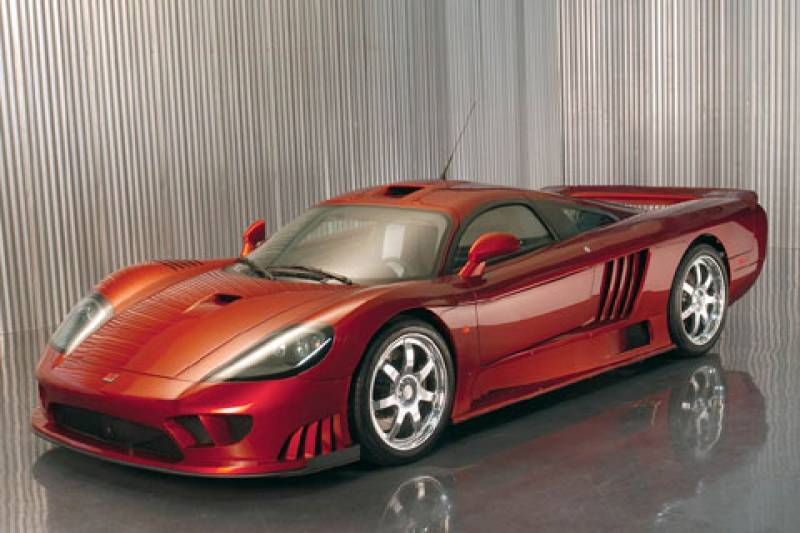
saleen s7

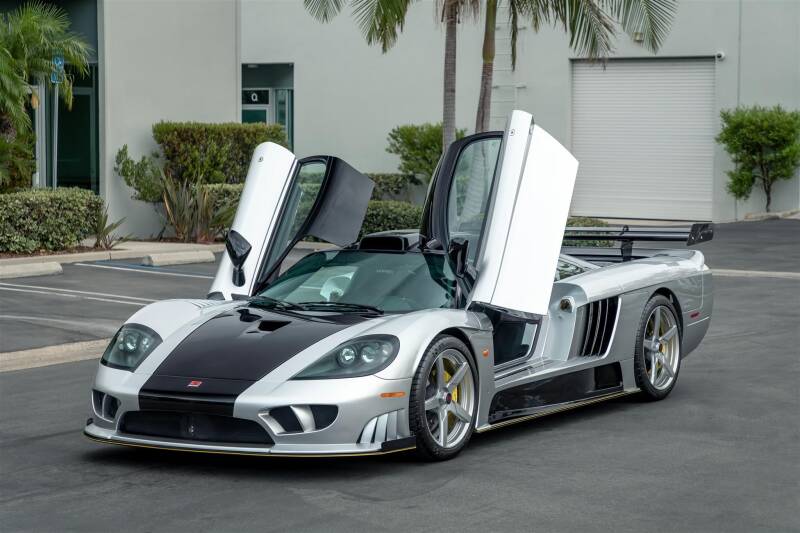

Designed, engineered, certified, manufactured and marketed by Saleen, Inc., the S7 was conceived to combine the performance of a track-only race car with the driving pleasure of a road car. Working with some of the world’s most respected and technologically advanced automotive suppliers, the S7 went from concept to first customer delivery in just 18 months.
A true supercar, the Saleen S7 is capable of over 400km/h. Zero-to-100 time is under four seconds. With its extreme ground effects engineering, at 257 km/h the car can be driven upside down and maintain contact with the road.

factory five f9r



The Factory Five F9R is a two seat build-it-yourself sports car developed with the latest generation space frame chassis. Retaining a coupe shape, the F9R is a wonderful piece of design, with steeply raked A-pillars creating a low roofline that sweeps back to a rear end that features retro-inspired louvered windows for an aggressive look. The shining jewel in the F9R crown is the Australian sourced engine, a fire-breathing 9.5-liter V12 unit built by Race Cast Engineering that elevates the humble LS to an all-new plane of otherworldly existence.


Hydra is a complete automotive design and fabrication studio bringing over 30 years of industry experience to solve any OEM design challenge. Our in-house expertise and world-class facilities can take a vehicle concept from concept to production – through creative design, engineering, CAD, fabrication, prototyping and pre-production capabilities.

2017 saleen s1



The Saleen S1, also called the Saleen 1, is a two-seater sports car developed and built by American automobile manufacturer Saleen Automotive. It was unveiled at the 2017 LA Auto Show, and is the first car developed entirely by Saleen since the Saleen S7 ended production in 2009. Production of the S1 is planned to be 1,500 units yearly, with a starting price of US$100,000 each. The S1 is powered by a proprietary 2.5 litre turbocharged inline-four engine developed in-house by Saleen, rated at 450 hp.

2021 lordstown endurance



The Lordstown Endurance is a full-size electric pickup truck concept by Lordstown Motors that, as of October 2021, is planned to be produced no earlier than April 2022. The company had no firm orders for the truck. It is planned to be the company's first production automobile. By October 2021, the announced production date for the Endurance had been delayed until April 2022, following the September news that the Lordstown auto plant would be sold to Foxconn.

DM blade
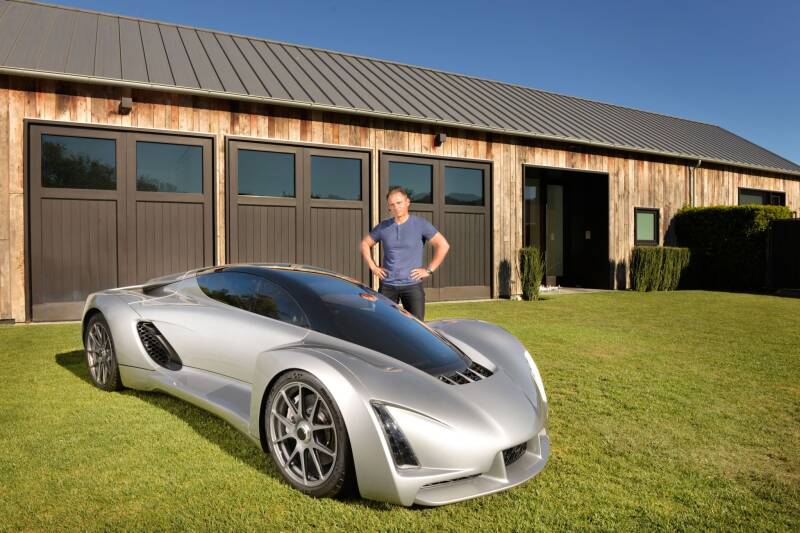


Divergent Microfactories (DM) Blade is the world’s first 3D printed supercar. Aimed at revolutionizing the way that cars are designed and produced, the DM Blade is an ultra-lightweight vehicle that utilizes cutting-edge technology to minimize both the cost and environmental impact of manufacturing cars. When looking at total emissions of a vehicle, including those from manufacturing, the DM Blade has one third of the environmental impact of any other electric car – it also happens to go 0-60 in about two seconds, boasts 700 horsepower and has twice the power-to-weight ratio of a Bugatti Veyron.




Create Your Own Website With JouwWeb